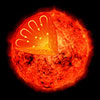CXC Home | Search | Help | Image Use Policy | Latest Images | Privacy | Accessibility | Glossary | Q&A
Tour of GJ 3253
Quicktime MPEG With closed-captions (at YouTube)
Despite appearing as a steady yellow disk in our sky, the Sun is actually an incredibly active ball of superheated gas. Sometimes the Sun has storms that launch from its surface and send energy and particles into the Solar System. On Earth, these solar storms can generate auroras, damage satellites and power grids, and potentially harm astronauts in orbit.
Therefore, many scientists are working hard to better understand what causes the Sun to act as it does. They do know that the Sun's magnetic fields are largely responsible for producing its behavior, but there are still many details that remain mysterious.
By studying the X-ray emission of four stars with lower masses than the Sun, a pair of astronomers may have made an important discovery. They found that these lower-mass stars have magnetic fields that are similar in strength to stars like the Sun. This is surprising because the Sun and Su-like stars have different regions within them where energy flows differently. Astronomers have thought the boundary between these different regions would contribute to the strength of the magnetic fields. If stars without such a boundary - like those in this latest study - have magnetic fields of similar strength, then this theory may need to be re-examined.
[Runtime: 02:23]
Quicktime MPEG With closed-captions (at YouTube)
Despite appearing as a steady yellow disk in our sky, the Sun is actually an incredibly active ball of superheated gas. Sometimes the Sun has storms that launch from its surface and send energy and particles into the Solar System. On Earth, these solar storms can generate auroras, damage satellites and power grids, and potentially harm astronauts in orbit.
Therefore, many scientists are working hard to better understand what causes the Sun to act as it does. They do know that the Sun's magnetic fields are largely responsible for producing its behavior, but there are still many details that remain mysterious.
By studying the X-ray emission of four stars with lower masses than the Sun, a pair of astronomers may have made an important discovery. They found that these lower-mass stars have magnetic fields that are similar in strength to stars like the Sun. This is surprising because the Sun and Su-like stars have different regions within them where energy flows differently. Astronomers have thought the boundary between these different regions would contribute to the strength of the magnetic fields. If stars without such a boundary - like those in this latest study - have magnetic fields of similar strength, then this theory may need to be re-examined.
[Runtime: 02:23]
(Credit: NASA/CXC/A. Hobart)
Is the Sun Really a Giant Pokemon?
Quicktime MPEG
Over the last few weeks Pokémon Go has taken the world by storm. Visit the beach and you'll see dozens of people battling to catch water-type Pokémon like Magikarp or Krabby. Take a walk in the countryside and you'll find yourself surrounded by grass-type Caterpies.
But what type of Pokémon would you find in space?
While the Sun is obviously not a Pokémon, it actually has a lot in common with an electric-type Pokémon called Magneton. 'Discharge' and 'Zap Cannon' are two of Magneton's most powerful attacks.
Similarly, the Sun can create powerful storms capable of knocking out communication satellites and damaging electrical power systems on Earth!
These storms are caused by 'magnetic fields' on the Sun. A magnet (like those you can stick to your refrigerator) creates an invisible force field all around it, called a magnetic field. The Sun acts like a magnet. But how the Sun, and stars like the Sun, create their magnetic fields is a bit of a puzzle.
The inside of a star is made of layers. There's a zone where the star's energy moves outwards, and another where the energy circles up and down. Many scientists believe that stars' magnetic fields are produced in the area where these two layers meet.
However, stars much less massive than the Sun don't have both these layers, as you can see in the picture above. Yet a new study has just found that they still have magnetic fields similar to stars like the Sun!
It looks like our theory of magnetic fields needs to be re-examined!
[Runtime: 02:22]
Quicktime MPEG
Over the last few weeks Pokémon Go has taken the world by storm. Visit the beach and you'll see dozens of people battling to catch water-type Pokémon like Magikarp or Krabby. Take a walk in the countryside and you'll find yourself surrounded by grass-type Caterpies.
But what type of Pokémon would you find in space?
While the Sun is obviously not a Pokémon, it actually has a lot in common with an electric-type Pokémon called Magneton. 'Discharge' and 'Zap Cannon' are two of Magneton's most powerful attacks.
Similarly, the Sun can create powerful storms capable of knocking out communication satellites and damaging electrical power systems on Earth!
These storms are caused by 'magnetic fields' on the Sun. A magnet (like those you can stick to your refrigerator) creates an invisible force field all around it, called a magnetic field. The Sun acts like a magnet. But how the Sun, and stars like the Sun, create their magnetic fields is a bit of a puzzle.
The inside of a star is made of layers. There's a zone where the star's energy moves outwards, and another where the energy circles up and down. Many scientists believe that stars' magnetic fields are produced in the area where these two layers meet.
However, stars much less massive than the Sun don't have both these layers, as you can see in the picture above. Yet a new study has just found that they still have magnetic fields similar to stars like the Sun!
It looks like our theory of magnetic fields needs to be re-examined!
[Runtime: 02:22]
(Credit: NASA/CXC/April Jubett)
Return to GJ 3253 (July 27, 2016)




